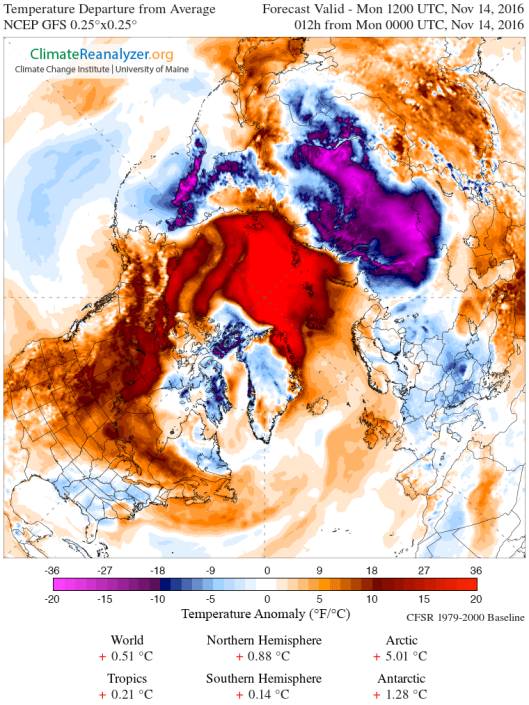For The Arctic Ocean Above 80 North, It’s Still Summer in November
14
November, 2016
It’s
going to be the hottest year on record — by a long shot. Just
ask Gavin Schmidt at a NASA that the climate change denying Trump
Administration has now imperiled.
But in one region — the Arctic — the rate of heat accumulation
has been outrageously extreme. And it is there that this new record
warmth could inflict some of the worst damage to an increasingly
fragile Earth System.
Summer
Heat During Fall Above 80 North
For
in the Arctic Ocean above the 80 degree north latitude line which
encircles the crest of our world, temperatures
today are around 17 degrees Celsius above average.These
are the warmest temperatures for this region ever recorded.
And they include numerous locations in which temperatures spike to
well above 20 C (36 F) warmer than average.
(Temperatures
above the 80 degree north latitude line during mid November are about
equal to what you would typically expect for late summer. This record
warmth in the Arctic is notably severe and could produce serious near
term climate and weather impacts. Image source: DMI.)
Taken
in total, this region — one that includes the North Pole — is
currently experiencing temperatures that it would typically see from
September 15 through 21. In other words, it’s
about as warm now, on November 14th, in the zone surrounding the
North Pole as it typically is during the last week of summer.
It
wouldn’t be quite so bad if temperatures had simply rocketed to new
highs on this particular day as part of a wild temperature swing.
Unfortunately, readings instead have remained consistently high
throughout autumn. They have levitated off the baseline 1958-2002
average range for the better part of 80 days. And as temperatures
maintained near late summer or early fall averages, the departure
from normal (represented by the green line in the graph above) has
continued to intensify throughout November. Such long-term
maintenance of high temperatures risks producing some severe lasting
impacts on both the Arctic and the global environment.
The
North Pole’s Big Red Hole
The
temperature range we see now is nothing less than astonishing and, to
this particular observer, terrifying. A huge hole has been blown in
the heart of what should be the building cold of winter. And if it
doesn’t reform soon, it will have some serious knock-on climate
effects to include worsening
atmospheric circulation changes,
related increasingly extreme weather, impacts to growing seasons,
impacts to sea ice, impacts to Greenland ice, and impacts to life in
the Arctic and beyond.
(Today,
large swaths of the Arctic Ocean are expected to see temperatures hit
20 C [36 F] + warmer than normal. These temperatures are so high that
recently ice-covered sections will, over the next five days,
experience temperatures between -2 C and 0 C — or warm enough to
produce temporary melt. Such a condition has never been witnessed to
the extent that it is now so late in the year. A clear sign that
global warming is starting to bite deeper than we had hoped. Image
source: Climate
Reanalyzer.
Note — the map shows temperature departures above [red shift] and
below [blue shift] the, already warmer than normal, 1979-2000
baseline average.)
This
record fall warmth appears to be part of an ever-more-pervasive
‘death of winter’ type scenario related to human-caused global
warming. And unless temperatures in the Arctic revert back toward
base-line pretty soon, we are at increasing risk of hitting some
state-change tipping points. In particular, these center around a
nearer term loss of Arctic Ocean ice than expected. An event that
could happen this year if we experience an anomalously warm winter
followed by a similarly warm summer — but one that many experts
expect to hold off until the 2030s. An alteration that, longer
term, under
the continued fossil fuel burning presently promoted by the Trump
Administration,
basically removes winter as a season pretty much altogether (at least
as we know it).
I
sincerely hope that we see a return to baseline temperature
conditions in the Arctic soon. But as the days roll by, this seems
less and less likely. Warm winds keep flowing in both from the
Barents and the Bering. And the centers of coldest Northern
Hemisphere regions are well displaced toward Siberia and Greenland.
If this situation continues, implications for summer sea ice during
2017 could be pretty rough (more on this in the follow-on post). And
it’s at the point where we hit ice-free summer states in the Arctic
Ocean that some very radical regional, hemispheric, and global
changes (which
produce even worse effects than some of the bad outcomes we’ve
already seen)
will be well underway.
Links:
(UPDATED)





No comments:
Post a Comment
Note: only a member of this blog may post a comment.